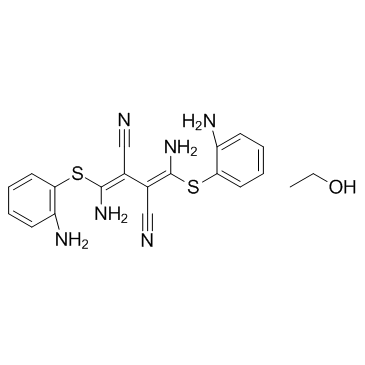1173097-76-1
| Name | (2Z,3Z)-2,3-bis[amino-(2-aminophenyl)sulfanylmethylidene]butanedinitrile,ethanol |
|---|---|
| Synonyms |
U0126-EtOH
(2Z,3Z)-Bis{amino[(2-aminophenyl)sulfanyl]methylene}succinonitrile - ethanol (1:1) U0126-EtOH,U-0126 U0126 ethanolate S1102_Selleck Butanedinitrile, 2,3-bis[amino[(2-aminophenyl)thio]methylene]-, (2Z,3Z)-, compd. with ethanol (1:1) CS-0173 U0126 |
| Description | U0126 is a potent and non-ATP competitive MEK1 and MEK2 inhibitor, with IC50s of 70 nM and 60 nM, respectively. |
|---|---|
| Related Catalog | |
| Target |
MEK2:60 nM (IC50) MEK1:70 nM (IC50) Autophagy Mitophagy |
| In Vitro | Treatment with U0126 efficiently reduces progeny virus titers of all tested strains in A549 cells. While nM concentrations of U0126 are efficient to reduce H1N1v and H5N1 (MB1), μM concentrations of U0126 are required to reduce the virus titer of H5N1 (GSB) and H7N7. The EC50 values for U0126 against H1N1v are 1.2±0.4 μM in A549 cells and 74.7±1.0 μM in MDCKII cells[2].Rat hepatocarcinoma cells (FAO) stimulated by fetal calf serum (FCS) exhibits a significant proportion in S phase (32.62%) whereas U0126 strongly decreases the proportion of cells in S phase (9.92%) and increases the proportion of cells in G0-G1 phase and to a lesser extent in G2/M[3]. |
| In Vivo | Mice are treated daily with U0126 (i.p., 10.5 mg/kg). In control experiment, tumor sizes are constant or slightly increase all over the kinetic. At the opposite, in all U0126 experiments, engraftment and early tumor growth are significantly decreased. Furthermore, a 60-70% reduction in the volume of tumors treated with U0126 is obtained 9 days after injection and thereafter[3]. Rats are subjected to 120?minutes transient middle cerebral artery occlusion (tMCAO) and thereafter treated with the U0126 (i.p., 30 mg/kg) at 0 and 24 hours of reperfusion. After treatment with U0126, the vasoconstriction to S6c is markedly reduced[4]. |
| Cell Assay | A549 and MDCK II cells are seeded in 96-well culture plates at a density of 8×104 cells per well in minimal essential medium (MEM) containing 10% heat-inactivated fetal calf serum (FCS), 100 U/mL Penicillin, 100 mg/mL Streptomycin. Cells are incubated at 37°C with 5% CO2 overnight. Thereafter, cells are washed twice with PBS. MEM containing different concentrations of U0126 (0.001-1000 μM) is added to the cells. After addition of U0126, cells are incubated further for 48 h at 37°C and 5% CO2. Then, cells are fixed by incubation for 30 min at 4°C with 100 μL 4% paraformaldehyde (PFA). Adding 100 μL crystal violet for 30 min at room temperature stained viable cells. After staining, plates are washed and dried. For the extraction of crystal violet from viable cells 100 μL of 100% methanol is added to each well. After incubation for 30 min at room temperature, the extinction is measured with an enzyme-linked immunosorbent assay (ELISA) reader at OD=490 nm. The percentage of cell viability after treatment with the antiviral compound is calculated[2]. |
| Animal Admin | Mice[3] Athymic female nude mice (SWISS, nu/nu) are used. Prior to injection, FI cells are labeled with a stable fluorescent dye molecule, DiA at 10 μg/mL for 5 h at 37°C. After washing to remove free DiA, cells are trypsinized for inoculation (U0126 experiments) or transfection (RNAi experiments). Biliary epithelial cells are injected subcutaneously, at the indicated times, into the tibia of nude mice. In the chemical experiments, 3 h after inoculation, mice are treated with U0126 (10.5 mg/kg) daily by intraperitoneal injection. The length and width of each tumor are measured every day by using a caliper. The following formula is used to calculate tumor volumes=width2×length/2. Mice are killed at the end of experiment. Tumors are immediately frozen in liquid nitrogen. Rats[4] Twelve-week-old female Wistar rats (250 to 265 g) are used U0126 (30 mg/kg intraperitoneally) is injected at 0 and 24 hours of reperfusion after tMCAO based on the previous evaluation of the drug in male rats. Animals in study II are administered U0126 or vehicle and are killed 14 days after tMCAO. Experimental group assignments are randomized and blinded to the surgical experimenter. |
| References |
| Boiling Point | 612.5ºC at 760 mmHg |
|---|---|
| Molecular Formula | C20H22N6OS2 |
| Molecular Weight | 426.558 |
| Flash Point | 324.2ºC |
| Exact Mass | 426.129639 |
| PSA | 222.49000 |
| LogP | 5.68476 |
| Storage condition | -20°C |
